Renewable On-Site Power Generation for Manufacturing Companies—Technologies, Modeling, and Dimensioning
Abstract
1. Introduction
2. Literature-Based Materials
2.1. Decentralized, Renewable Generation Technologies
2.2. Modeling of Generation Technologies
2.2.1. Stochastic Modeling Methods
2.2.2. Simulation-Driven Modeling
2.3. Dimensioning of Generation Technology
2.3.1. Main Optimization Methods
2.3.2. Existing Approaches of Application
2.3.3. Developed Software Solutions
3. Need for Research and Methodology
4. Technologies for Renewable Energy Generation in Production Systems
4.1. Overview of Properties and Restrictions in Application
- The technical aspects include properties to be assigned to the physical, facility-specific behavior of the technology.
- The energetic aspects are a subset of the technical aspects, as they describe the physical properties of the technology that specifically reflect the energetic behavior.
- The economic aspects relate technologies to business administration and economy.
- The ecological aspects address the sustainability of the technology.
4.2. Modeling of Generation Behavior
4.2.1. Data Collection and Pre-Processing
4.2.2. Model Setup
4.3. Dimensioning of Generation Technologies
4.3.1. Requirements for Dimensioning Generation Technologies with Regard to On-Site Generation
- The generation technologies must be modeled with highly accurate optimization results and with reasonable computational effort.
- The optimization method must be able to represent long-term periods (up to one year) with short time intervals (in the range of minutes).
- The implementation of technological restrictions in the dimensioning and the operation of the generation technologies should include economic correlations (including scaling effects).
- It must be possible to implement interfaces to an existing program for operation strategies.
4.3.2. Dimensioning On-Site Power Generation Using Linear Programming and Mixed-Integer Linear Programming
- reduction of peak loads to cut the demand rate
- reducing the total amount of purchased electricity to lower the energy unit price
- ensuring a highly reliable electricity supply to permit the uninterrupted operation of production facilities
- collecting additional revenues by participating in the energy market and selling electricity or providing energy system services (balancing power)
- lessening greenhouse gas emissions
- further company-specific targets
5. Exemplary Application
5.1. Description of the Use Case
5.2. Model Parametrization
5.3. Results for the Exemplary Use Case
5.4. Conculsion Regrading the Exemplary Use Case
6. Summary and Outlook
Author Contributions
Funding
Institutional Review Board Statement
Informed Consent Statement
Data Availability Statement
Acknowledgments
Conflicts of Interest
References
- European Commission. Communication from the Commission to the European Parliament, the European Council, the Council, the European Economic and Social Committee and the Committee of the Regions: The European Green Deal. 2019. Available online: https://eur-lex.europa.eu/legal-content/EN/TXT/HTML/?uri=CELEX:52019DC0640&from=EN (accessed on 23 December 2020).
- AGORA Energiewende. Die Energiewende im Stromsektor: Stand der Dinge 2019: Rückblick auf die Wesentlichen Entwicklungen sowie Ausblick auf 2020. 2020. Available online: https://static.agora-energiewende.de/fileadmin/Projekte/2019/Jahresauswertung_2019/171_A-EW_Jahresauswertung_2019_WEB.pdf (accessed on 23 December 2020).
- Buhl, H.U.; Fridgen, G.; Körner, M.-F.; Michaelis, A.; Rägo, V.; Schöpf, M.; Schott, P.; Sitzmann, A. Ausgangsbedingungen für die Vermarktung von Nachfrageflexibilität: Status-quo-Analyse und Metastudie. 2019. Available online: https://www.econstor.eu/bitstream/10419/203143/1/1672807395.pdf (accessed on 23 December 2020). [CrossRef]
- Deutsches Bundesministerium für Wirtschaft und Energie. Internationaler Energiepreisvergleich für Industrie: Erdgas und Elektrizität. 2020. Available online: https://www.bmwi.de/Redaktion/DE/Binaer/Energiedaten/Energiepreise-und-Energiekosten/energiedaten-energiepreise-4-xls.xlsx?__blob=publicationFile&v=33 (accessed on 23 December 2020).
- Umweltbundesamt. “Grüne” Produkte: Marktzahlen. 2020. Available online: https://www.umweltbundesamt.de/daten/private-haushalte-konsum/konsum-produkte/gruene-produkte-marktzahlen#umsatz-mit-grunen-produkten (accessed on 23 December 2020).
- Gerlach, A.; Werner, C.; Breyer, C. Impact of Financing Cost on Global Grid-Parity Dynamics till 2030. In Proceedings of the 29th EU PVSEC, Amsterdam, The Netherlands, 22–26 September 2014. [Google Scholar]
- Schulz, J.; Scharmer, V.M.; Zaeh, M.F. Energy self-sufficient manufacturing systems—Integration of renewable and decentralized energy generation systems. Procedia Manuf. 2020, 43, 40–47. [Google Scholar] [CrossRef]
- Schulz, J.; Rosenberg, F.; Scharmer, V.M.; Zaeh, M.F. Characterization of Energy Consumers in Production Systems with Renewable On-Site Power Generation. IFIP Adv. Inf. Commun. Technol. 2020, 591, 19–27. [Google Scholar] [CrossRef]
- Quaschning, V. Regenerative Energiesysteme: Technologie—Berechnung—Klimaschutz; 10., Aktualisierte und Erweiterte Auflage; Hanser: München, Germany, 2019; ISBN 9783446461130. [Google Scholar]
- International Renewable Energy Agency. Tranforming the Energy System: And Holding the Line on Rising Global Temperatures. 2019. Available online: https://www.irena.org/-/media/Files/IRENA/Agency/Publication/2019/Sep/IRENA_Transforming_the_energy_system_2019.pdf (accessed on 23 December 2020).
- Patrao, I.; Figueres, E.; Garcerá, G.; González-Medina, R. Microgrid architectures for low voltage distributed generation. Renew. Sustain. Energy Rev. 2015, 43, 415–424. [Google Scholar] [CrossRef]
- Energietechnische Gesellschaft im VDE. VDE-Studie: Dezentrale Energieversorgung 2020. 2007. Available online: https://www.vde.com/resource/blob/792808/db366b86af491989fcd2c6ba6c6f21ad/etg-studie-dezentrale-energieversorgung2020-komplette-studie-data.pdf (accessed on 23 December 2020).
- Deutscher Industrie- und Handelskammertag. IHK-Energiewende-Barometer 2018—Fakten, Trends, Forderungen; IHK: Berlin, Brüssel, 2018; ISBN 2196-9876. [Google Scholar]
- Bons, M.; Creutzburg, P.; Schlemme, J. Energiewende in der Industrie: Potentiale und Wechselwirkungen mit dem Energiesektor; Navigant Energy Germany GmbH: Berlin, Germany, 2020. [Google Scholar]
- Waldmann, K.-H.; Stocker, U.M. Stochastische Modelle; Springer: Berlin/Heidelberg, Germany, 2004. [Google Scholar]
- Talari, S.; Shafie-khah, M.; Osório, G.J.; Aghaei, J.; Catalão, J.P.S. Stochastic modelling of renewable energy sources from operators’ point-of-view: A survey. Renew. Sustain. Energy Rev. 2018, 81, 1953–1965. [Google Scholar] [CrossRef]
- Chiacchio, F.; D’Urso, D.; Famoso, F.; Brusca, S.; Aizpurua, J.I.; Catterson, V.M. On the use of dynamic reliability for an accurate modelling of renewable power plants. Energy 2018, 151, 605–621. [Google Scholar] [CrossRef]
- Mehrjerdi, H.; Rakhshani, E. Correlation of multiple time-scale and uncertainty modelling for renewable energy-load profiles in wind powered system. J. Clean. Prod. 2019, 236, 117644. [Google Scholar] [CrossRef]
- Würth, I.; Valldecabres, L.; Simon, E.; Möhrlen, C.; Uzunoğlu, B.; Gilbert, C.; Giebel, G.; Schlipf, D.; Kaifel, A. Minute-Scale Forecasting of Wind Power—Results from the Collaborative Workshop of IEA Wind Task 32 and 36. Energies 2019, 12, 712. [Google Scholar] [CrossRef]
- Kim, S.-G.; Jung, J.-Y.; Sim, M. A Two-Step Approach to Solar Power Generation Prediction Based on Weather Data Using Machine Learning. Sustainability 2019, 11, 1501. [Google Scholar] [CrossRef]
- Sheng, H.; Xiao, J.; Cheng, Y.; Ni, Q.; Wang, S. Short-Term Solar Power Forecasting Based on Weighted Gaussian Process Regression. IEEE Trans. Ind. Electron. 2018, 65, 300–308. [Google Scholar] [CrossRef]
- Meschede, H.; Hesselbach, J.; Child, M.; Breyer, C. On the impact of probabilistic weather data on the economically optimal design of renewable energy systems—A case study on La Gomera island. International Journal of Sustainable Energy Planning and Management. Int. J. Sustain. Energy Plan. Manag. 2019, 23. [Google Scholar] [CrossRef]
- Chirapongsananurak, P.; Santoso, S. Multi-Time-Scale Simulation Tool for Renewable Energy Integration Analysis in Distribution Circuits. Inventions 2017, 2, 7. [Google Scholar] [CrossRef]
- Huber, M.; Dimkova, D.; Hamacher, T. Integration of wind and solar power in Europe: Assessment of flexibility requirements. Energy 2014, 69, 236–246. [Google Scholar] [CrossRef]
- Luna-Rubio, R.; Trejo-Perea, M.; Vargas-Vázquez, D.; Ríos-Moreno, G.J. Optimal sizing of renewable hybrids energy systems: A review of methodologies. Sol. Energy 2012, 86, 1077–1088. [Google Scholar] [CrossRef]
- Faccio, M.; Gamberi, M.; Bortolini, M.; Nedaei, M. State-of-art review of the optimization methods to design the configuration of hybrid renewable energy systems (HRESs). Front. Energy 2018, 12, 591–622. [Google Scholar] [CrossRef]
- Lian, J.; Zhang, Y.; Ma, C.; Yang, Y.; Chaima, E. A review on recent sizing methodologies of hybrid renewable energy systems. Energy Convers. Manag. 2019, 199, 112027. [Google Scholar] [CrossRef]
- Sinha, S.; Chandel, S.S. Review of recent trends in optimization techniques for solar photovoltaic–wind based hybrid energy systems. Renew. Sustain. Energy Rev. 2015, 50, 755–769. [Google Scholar] [CrossRef]
- Abdmouleh, Z.; Gastli, A.; Ben-Brahim, L.; Haouari, M.; Al-Emadi, N.A. Review of optimization techniques applied for the integration of distributed generation from renewable energy sources. Renew. Energy 2017, 113, 266–280. [Google Scholar] [CrossRef]
- Anoune, K.; Bouya, M.; Astito, A.; Abdellah, A.B. Sizing methods and optimization techniques for PV-wind based hybrid renewable energy system: A review. Renew. Sustain. Energy Rev. 2018, 93, 652–673. [Google Scholar] [CrossRef]
- Al-falahi, M.D.A.; Jayasinghe, S.D.G.; Enshaei, H. A review on recent size optimization methodologies for standalone solar and wind hybrid renewable energy system. Energy Convers. Manag. 2017, 143, 252–274. [Google Scholar] [CrossRef]
- Jacob, A.S.; Banerjee, R.; Ghosh, P.C. Sizing of hybrid energy storage system for a PV based microgrid through design space approach. Appl. Energy 2018, 212, 640–653. [Google Scholar] [CrossRef]
- Tina, G.M.; Gagliano, S. Probabilistic modelling of hybrid solar/wind power system with solar tracking system. Renew. Energy 2011, 36, 1719–1727. [Google Scholar] [CrossRef]
- Chauhan, A.; Saini, R.P. A review on Integrated Renewable Energy System based power generation for stand-alone applications: Configurations, storage options, sizing methodologies and control. Renew. Sustain. Energy Rev. 2014, 38, 99–120. [Google Scholar] [CrossRef]
- Bradley, S.P.; Hax, A.C.; Magnanti, T.L. Applied Mathematical Programming; Addison-Wesley: Reading, MA, USA, 1977; ISBN 978-0201004649. [Google Scholar]
- Thiem, S. Multi-Modal On-Site Energy Systems: Development and Application of a Superstructure-Based Optimization Method for Energy System Design under Consideration of Part-Load Efficiencies; Technical University of Munich: Munich, Germany, 2017. [Google Scholar]
- Biethahn, J.; Hönerloh, A.; Kuhl, J.; Leisewitz, M.-C.; Nissen, V.; Tietze, M. Betriebswirtschaftliche Anwendungen des Soft Computing; Vieweg+Teubner Verlag: Wiesbaden, Germany, 1998. [Google Scholar]
- Kennedy, J.; Eberhart, R. Particle Swarm Optimization. In Proceedings of the ICNN’95-international conference on neural networks, Toronto, ON, Canada, 14–17 May 1995; pp. 1942–1948. [Google Scholar]
- Dorigo, M.; Maniezzo, V.; Colorni, A. The ant system: Optimization by a colony of cooperating agents. IEEE Trans. Syst. Man Cybern. Part B 1996, 26, 29–41. [Google Scholar] [CrossRef]
- Kirkpatrick, S.; Gelatt, C.D.; Vecchi, M.P. Optimization by simulated annealing. Science 1983, 220, 671–680. [Google Scholar] [CrossRef]
- Nowicki, E.; Smutnicki, C. A Fast Taboo Search Algorithm for the Job Shop Problem. Manag. Sci. 1996, 42, 797–813. [Google Scholar] [CrossRef]
- Rao, S.S. Engineering Optimization: Theory and Practice, 5th ed.; Wiley: Hoboken, NJ, USA, 2020; ISBN 9781119454793. [Google Scholar]
- Lämmel, U.; Cleve, J. Künstliche Intelligenz: Wissensverarbeitung—Neuronale Netze, 5.; überarbeitete Auflage; Carl Hanser Verlag: München, Germany, 2020; ISBN 978-3-446-46363-9. [Google Scholar]
- Ming, B.; Liu, P.; Guo, S.; Zhang, X.; Feng, M.; Wang, X. Optimizing utility-scale photovoltaic power generation for integration into a hydropower reservoir by incorporating long- and short-term operational decisions. Appl. Energy 2017, 204, 432–445. [Google Scholar] [CrossRef]
- Scheubel, C.; Zipperle, T.; Tzscheutschler, P. Modeling of industrial-scale hybrid renewable energy systems (HRES)—The profitability of decentralized supply for industry. Renew. Energy 2017, 108, 52–63. [Google Scholar] [CrossRef]
- Atwa, Y.M.; El-Saadany, E.F.; Salama, M.M.A.; Seethapathy, R. Optimal Renewable Resources Mix for Distribution System Energy Loss Minimization. IEEE Trans. Power Syst. 2010, 25, 360–370. [Google Scholar] [CrossRef]
- Upadhyay, S.; Sharma, M.P. Development of hybrid energy system with cycle charging strategy using particle swarm optimization for a remote area in India. Renew. Energy 2015, 77, 586–598. [Google Scholar] [CrossRef]
- Ma, T.; Yang, H.; Lu, L.; Peng, J. Pumped storage-based standalone photovoltaic power generation system: Modeling and techno-economic optimization. Appl. Energy 2015, 137, 649–659. [Google Scholar] [CrossRef]
- Zhang, W.; Maleki, A.; Rosen, M.A.; Liu, J. Sizing a stand-alone solar-wind-hydrogen energy system using weather forecasting and a hybrid search optimization algorithm. Energy Convers. Manag. 2019, 180, 609–621. [Google Scholar] [CrossRef]
- Lan, H.; Wen, S.; Hong, Y.-Y.; Yu, D.C.; Zhang, L. Optimal sizing of hybrid PV/diesel/battery in ship power system. Appl. Energy 2015, 158, 26–34. [Google Scholar] [CrossRef]
- Li, B.; Roche, R.; Miraoui, A. Microgrid sizing with combined evolutionary algorithm and MILP unit commitment. Appl. Energy 2017, 188, 547–562. [Google Scholar] [CrossRef]
- Zhang, W.; Maleki, A.; Rosen, M.A.; Liu, J. Optimization with a simulated annealing algorithm of a hybrid system for renewable energy including battery and hydrogen storage. Energy 2018, 163, 191–207. [Google Scholar] [CrossRef]
- Friedemann, C. Umweltorientierte Investitionsplanung; Gabler Verlag: Wiesbaden, Germany, 1998; ISBN 978-3-322-99167-6. [Google Scholar]
- Reich, G.; Reppich, M. Regenerative Energietechnik: Überblick über Ausgewählte Technologien zur Nachhaltigen Energieversorgung, 2nd ed.; Springer Vieweg: Wiesbaden, Germany, 2018; ISBN 978-3-658-20607-9. [Google Scholar]
- Grundig, C.-G. Fabrikplanung: Planungssystematik—Methoden—Anwendungen, 5th ed.; Hanser: München, Germany, 2015; ISBN 978-3-446-44215-3. [Google Scholar]
- Eiselt, J. Dezentrale Energiewende: Chancen und Herausforderungen; Springer Vieweg: Wiesbaden, Germany, 2012; ISBN 978-3-8348-2461-5. [Google Scholar]
- Hau, E. Windkraftanlagen: Grundlagen, Technik, Einsatz, Wirtschaftlichkeit, 5th ed.; Springer Vieweg: Berlin, Germany, 2014; ISBN 978-3-642-28876-0. [Google Scholar]
- Kaltschmitt, M.; Streicher, W.; Wiese, A. Erneuerbare Energien: Systemtechnik, Wirtschaftlichkeit, Umweltaspekte, 5th ed.; Springer Vieweg: Berlin, Germany, 2013; ISBN 978-3-642-03248-6. [Google Scholar]
- Sterner, M.; Stadler, I. Energiespeicher: Bedarf, Technologien, Integration; Springer Vieweg: Berlin, Germany, 2014; ISBN 978-3-642-37380-0. [Google Scholar]
- Karl, J. Dezentrale Energiesysteme: Neue Technologien im Liberalisierten Energiemarkt, 3rd ed.; Oldenbourg: München, Germany, 2012; ISBN 978-3-486-70885-1. [Google Scholar]
- Blum, L. Technologiebericht 2.2a Dezentrale Kraftwerke (Brennstoffzellen) Innerhalb des Forschungsprojekts TF_Energiewende. 2017. Available online: https://epub.wupperinst.org/frontdoor/deliver/index/docId/7049/file/7049_Dezentrale_Kraftwerke.pdf (accessed on 23 December 2020).
- Bitterlich, W.; Lohmann, U. Gasturbinenanlagen: Komponenten, Betriebsverhalten, Auslegung, Berechnung: Mit Ausführlichen Berechnungsbeispielen, 2nd ed.; Springer Vieweg: Wiesbaden, Germany, 2018; ISBN 978-3-658-15067-9. [Google Scholar]
- Tu, K.; Xiong, H.; Chen, F. Comprehensive Prediction of Generation Power in Photovoltaic Microgrid. In Proceedings of the 2019 IEEE 8th Joint International Information Technology and Artificial Intelligence Conference (ITAIC 2019), Chongqing, China, 24–26 May 2019; pp. 1116–1120. [Google Scholar] [CrossRef]
- Schael, M.; Neumann, C.; Richmann, S.; Rogat, A.; Sourkounis, C. Risk evaluation of a chemical production system regarding power quality implications. In Proceedings of the IET (Hrsg.): Mediterranean Conference on Power Generation, Transmission Distribution and Energy Conversion (MedPower 2016), Belgrade, Serbia, 6–9 November 2016. [Google Scholar] [CrossRef]
- Mariam, L.; Basu, M.; Conlon, M.F. Microgrid: Architecture, policy and future trends. Renew. Sustain. Energy Rev. 2016, 64, 477–489. [Google Scholar] [CrossRef]
- Praiselin, W.J.; Edward, J.B. A Review on Impacts of Power Quality, Control and Optimization Strategies of Integration of Renewable Energy Based Microgrid Operation. IJISA 2018, 10, 67–81. [Google Scholar] [CrossRef]
- Synwoldt, C. Dezentrale Energieversorgung mit Regenerativen Energien: Technik, Märkte, Kommunale Perspektiven; Springer Vieweg: Wiesbaden, Germany, 2016; ISBN 978-3-658-13046-6. [Google Scholar]
- Wesselak, V.; Schabbach, T.; Fischer, J.; Link, T. Handbuch Regenerative Energietechnik, 3rd ed.; Springer Vieweg: Berlin, Germany, 2017; ISBN 978-3-662-53072-6. [Google Scholar]
- Günther, M. Energieeffizienz durch Erneuerbare Energien: Möglichkeiten, Potenziale, Systeme; Springer Vieweg: Wiesbaden, Germany, 2015; ISBN 978-3-658-06752-6. [Google Scholar]
- Umweltbundesamt. Kennzahlen von Anlagen mit Kraft-Wärme-Kopplung (KWK). Available online: https://www.umweltbundesamt.de/bild/tab-kennzahlen-von-anlagen-kraft-waerme-kopplung (accessed on 23 December 2020).
- Lechner, C.; Seume, J. Stationäre Gasturbinen, 3rd ed.; Springer: Berlin/Heidelberg, Germany, 2019; ISBN 978-3-662-56133-1. [Google Scholar]
- Fraunhofer ISE. Stromgestehungskosten Erneuerbare Energien. 2018. Available online: https://www.ise.fraunhofer.de/content/dam/ise/de/documents/publications/studies/DE2018_ISE_Studie_Stromgestehungskosten_Erneuerbare_Energien.pdf (accessed on 23 December 2020).
- Schuster, T.; Rüdt von Collenberg, L. Investitionsrechnung: Kapitalwert, Zinsfuß, Annuität, Amortisation; Springer Gabler: Berlin, Germany, 2017; ISBN 978-3-662-47799-1. [Google Scholar]
- Heier, S. Windkraftanlagen: Systemauslegung, Netzintegration und Regelung, 6th ed.; Springer Vieweg: Wiesbaden, Germany, 2018; ISBN 978-3-8348-1426-5. [Google Scholar]
- Droste-Franke, B. Brennstoffzellen und Virtuelle Kraftwerke: Energie-, Umwelt- und Technologiepolitische Aspekte Einer Effizienten Hausenergieversorgung; Springer: Berlin, Germany, 2009; ISBN 978-3-540-85796-9. [Google Scholar]
- ASUE. Über die Wirtschaftlichkeit von Blockheizkraftwerken in Hotels. 2018. Available online: https://www.asue.de/sites/default/files/asue/themen/blockheizkraftwerke/2018/broschueren/510034_asue_bhkw_in_hotels.pdf (accessed on 23 December 2020).
- BHKW Infozentrum. Veränderung der Wirtschaftlichkeit einer KWK-Anlage bei Wegfall der Eigenstromprivilegierung. 2014. Available online: https://www.bhkw-infozentrum.de/aktuelle-bhkw-statements/kwk-wirtschaftlichkeitsvergleich-ohne-und-mit-eeg-umlage-eigenstromprivilegierung.html (accessed on 23 December 2020).
- Prognose, A.G.; Fraunhofer, I.F.A.M.; Öko-Institut, E.V. BHKW Consult; Stiftung Umweltenergierecht. Evaluierung der Kraft-Wärme-Kopplung: Analysen der Entwicklung der Kraft-Wärme-Kopplung in einem Energiesystem mit Hohem Anteil erneuerbarer Energien. 2019. Available online: https://www.bmwi.de/Redaktion/DE/Publikationen/Studien/evaluierung-der-kraft-waerme-kopplung.pdf?__blob=publicationFile&v=6 (accessed on 23 December 2020).
- BMWi. Marktanalyse Wasserkraft. 2015. Available online: https://www.bmwi.de/Redaktion/DE/Downloads/M-O/marktanalyse-freiflaeche-photovoltaik-wasserkraft.pdf?__blob=publicationFile&v=1 (accessed on 23 December 2020).
- Umweltbundesamt. Erneuerbare Energien—Innovationen für die Zukunft. 2004. Available online: https://www.dlr.de/tt/Portaldata/41/Resources/dokumente/institut/system/publications/broschuere_ee_innov_zukunft.pdf (accessed on 23 December 2020).
- Zainuddin, H.; Shaari, S.; Omar, A.M.; Sulaiman, S.I. Power prediction for grid-connected photovoltaic system in Malaysia. In Proceedings of the IEEE, 3rd International Symposium & Exhibition in Sustainable Energy & Environment, Melaka, Malaysia, 1–3 June 2011; pp. 110–113. [Google Scholar] [CrossRef]
- Carrillo, C.; Obando Montaño, A.F.; Cidrás, J.; Díaz-Dorado, E. Review of power curve modelling for wind turbines. Renew. Sustain. Energy Rev. 2013, 21, 572–581. [Google Scholar] [CrossRef]
- Bruno, S.; Dicorato, M.; La Scala, M.; Sbrizzai, R.; Lombardi, P.A.; Arendarski, B. Optimal Sizing and Operation of Electric and Thermal Storage in a Net Zero Multi Energy System. Energies 2019, 12, 3389. [Google Scholar] [CrossRef]
- Atia, R.; Yamada, N. Sizing and Analysis of Renewable Energy and Battery Systems in Residential Microgrids. IEEE Trans. Smart Grid 2016, 7, 1204–1213. [Google Scholar] [CrossRef]
- Ohlhorst, D. Akteursvielfalt und Bürgerbeteiligung im Kontext der Energiewende in Deutschland: Das EEG und seine Reform. In Handbuch Energiewende und Partizipation; Holstenkamp, L., Radtke, J., Eds.; Springer Fachmedien Wiesbaden GmbH: Wiesbaden, Germany, 2018; pp. 101–124. [Google Scholar] [CrossRef]
- BMWi. Marktanalyse 2016: Stand und Entwicklung der weiltweiten Erneuerbare-Energien-Märkte. 2016. Available online: https://www.bmwi.de/EEE/Redaktion/DE/DENA/Downloads/Publikationen/Marktanalysen/20161212_marktanalyse_2016.pdf?__blob=publicationFile&v=4 (accessed on 23 December 2020).
- BDEW. Erneuerbare Energien und das EEG: Zahlen, Fakten, Grafiken: Anlagen, installierte Leistung, Stromerzeugung, EEG-Auszahlungen, Marktintegration der Erneuerbaren Energien und regionale Verteilung der EEG-Anlagen. 2016. Available online: https://www.bdew.de/media/documents/20160218_Energie-Info-Erneuerbare-Energien-und-das-EEG-2016.pdf (accessed on 23 December 2020).
- StMWi Bayern. Kleinwindkraftanlagen: Hintergrundinformtationen und Handlungsempfehlungen. 2018. Available online: https://www.stmwi.bayern.de/fileadmin/user_upload/stmwi/Publikationen/2018/2018-06-28_2018_Kleinwindkraftanlagen.pdf orientiert (accessed on 23 December 2020).
- Ingenierubüro Floecksmuehle. Vorbereitung und Begleitung bei der Erstellung eines Erfahrungsberuchts gemäßg § 97 Erneuerbare-Energien-Gesetz: Teilvorhaben II d: Wasserkraft. 2018. Available online: https://www.erneuerbare-energien.de/EE/Redaktion/DE/Downloads/bmwi_de/bericht-eeg-5-wasserkraft.pdf?__blob=publicationFile&v=4 (accessed on 23 December 2020).
- Bundesnetzargentur. Abrechnungsrelevante REgelungen des Standrad-Bilanzkreisvertrags. 2007. Available online: https://www.bundesnetzagentur.de/DE/Service-Funktionen/Beschlusskammern/1_GZ/BK6-GZ/2007/BK6-07-002/Abrechnungsrelevante%20Regelungen%20des%20Standard-Bilanzkreisvertrages.pdf?__blob=publicationFile&v=2 (accessed on 23 December 2020).
- BMWi. Zeitreihen zur Entwicklung der Erneuerbaren Energien in Deutschland. 2020. Available online: https://www.erneuerbare-energien.de/EE/Redaktion/DE/Downloads/zeitreihen-zur-entwicklung-der-erneuerbaren-energien-in-deutschland-1990-2019.pdf?__blob=publicationFile&v=26 (accessed on 23 December 2020).
- Konstantin, P. Praxisbuch Energiewirtschaft: Energieumwandlung, -Transport und -Beschaffung, Übertragungsnetzausbau und Kernenergieausstieg, 4th ed.; Springer Vieweg: Berlin, Germany, 2017; ISBN 978-3-662-49822-4. [Google Scholar]
- Ani, V.A. Optimal Operational Strategy for PV/Wind-Diesel Hybrid Power Generation System with Energy Storage. Int. J. Energy Optim. Eng. 2014, 3, 101–120. [Google Scholar] [CrossRef]
- Malheiro, A.; Castro, P.M.; Lima, R.M.; Estanqueiro, A. Integrated sizing and scheduling of wind/PV/diesel/battery isolated systems. Renew. Energy 2015, 83, 646–657. [Google Scholar] [CrossRef]
- Mandal, S.; Das, B.K.; Hoque, N. Optimum sizing of a stand-alone hybrid energy system for rural electrification in Bangladesh. J. Clean. Prod. 2018, 200, 12–27. [Google Scholar] [CrossRef]
- Zhao, B.; Zhang, X.; Li, P.; Wang, K.; Xue, M.; Wang, C. Optimal sizing, operating strategy and operational experience of a stand-alone microgrid on Dongfushan Island. Appl. Energy 2014, 113, 1656–1666. [Google Scholar] [CrossRef]
- González, A.; Riba, J.-R.; Rius, A.; Puig, R. Optimal sizing of a hybrid grid-connected photovoltaic and wind power system. Appl. Energy 2015, 154, 752–762. [Google Scholar] [CrossRef]
- Doleski, O.D. Herausforderung Utility 4.0: Wie sich die Energiewirtschaft im Zeitalter der Digitalisierung verändert; Springer Vieweg: Wiesbaden, Germany, 2017; ISBN 978-3-658-15736-4. [Google Scholar]
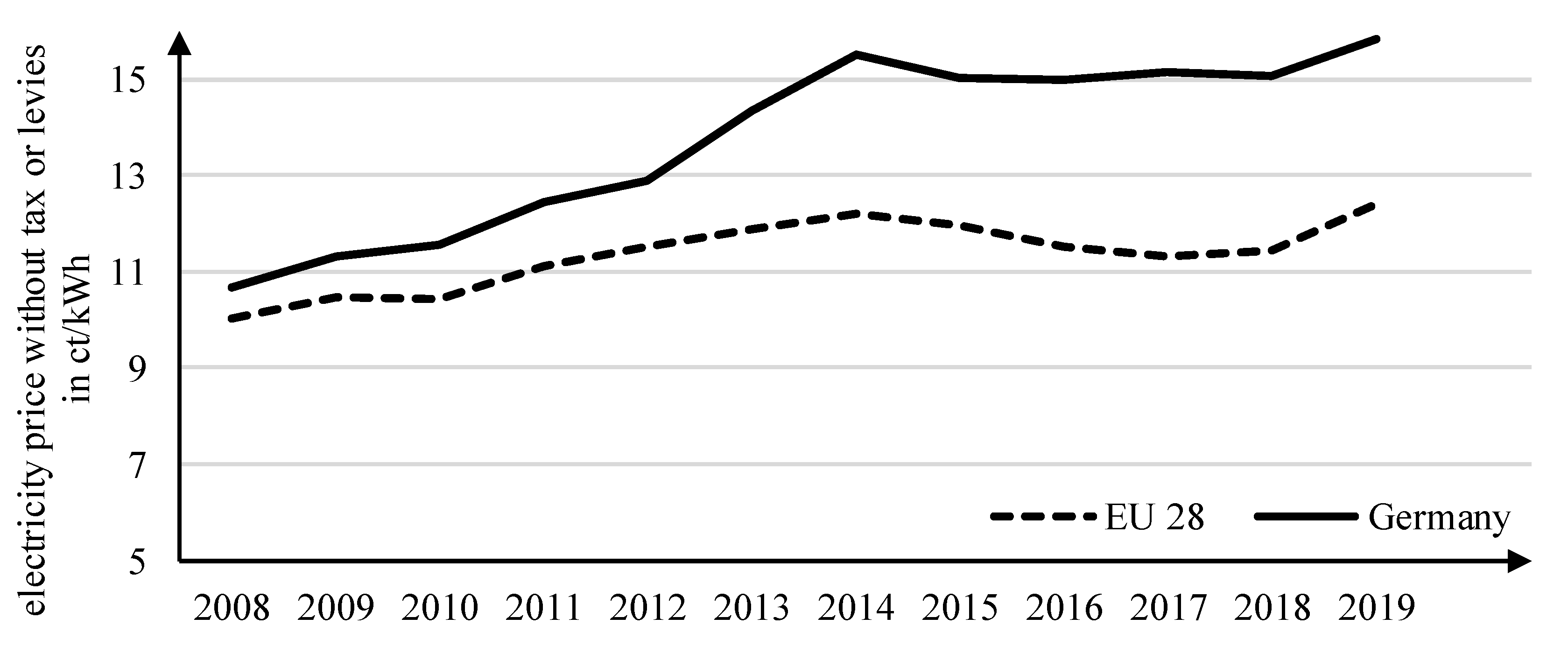


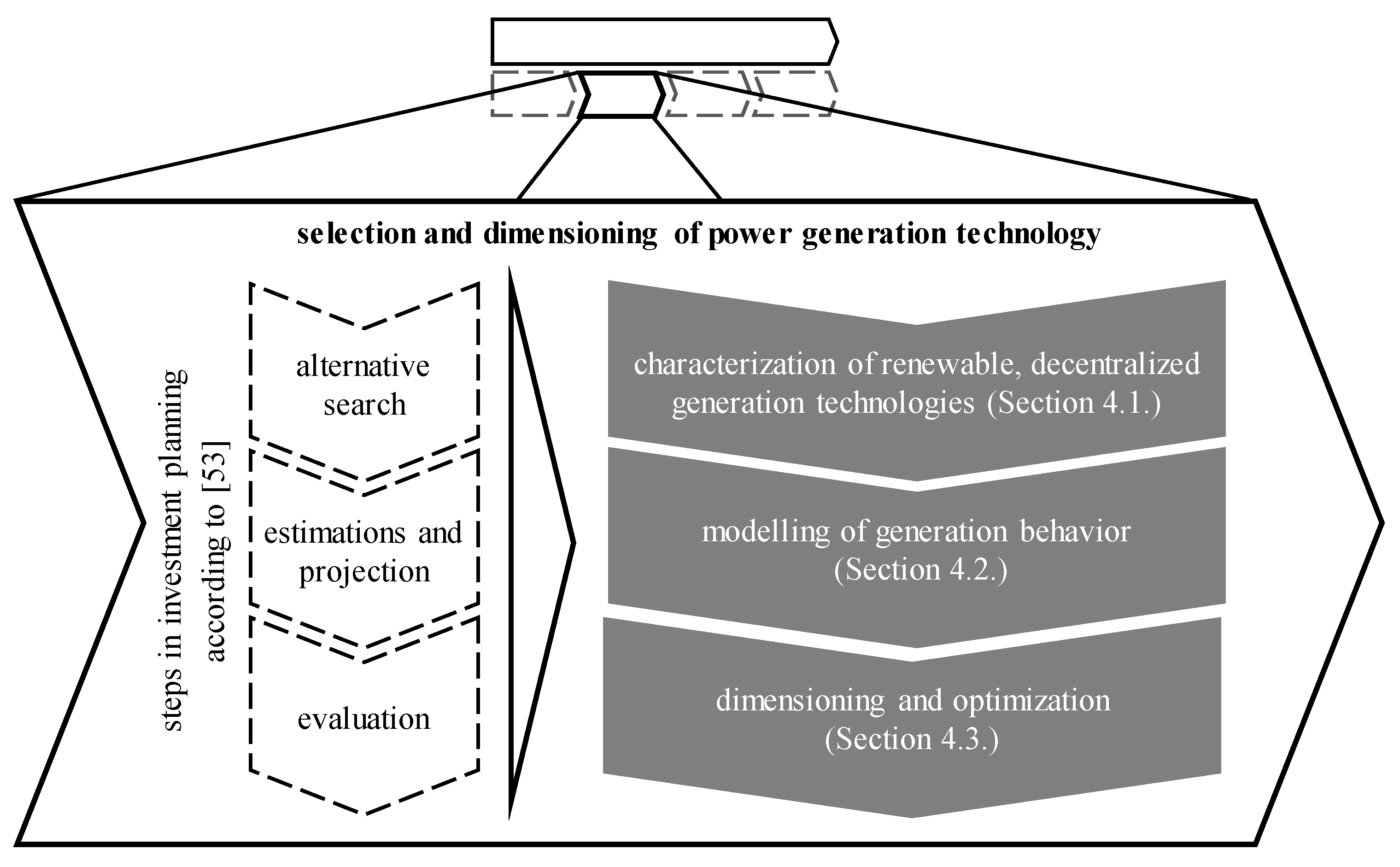
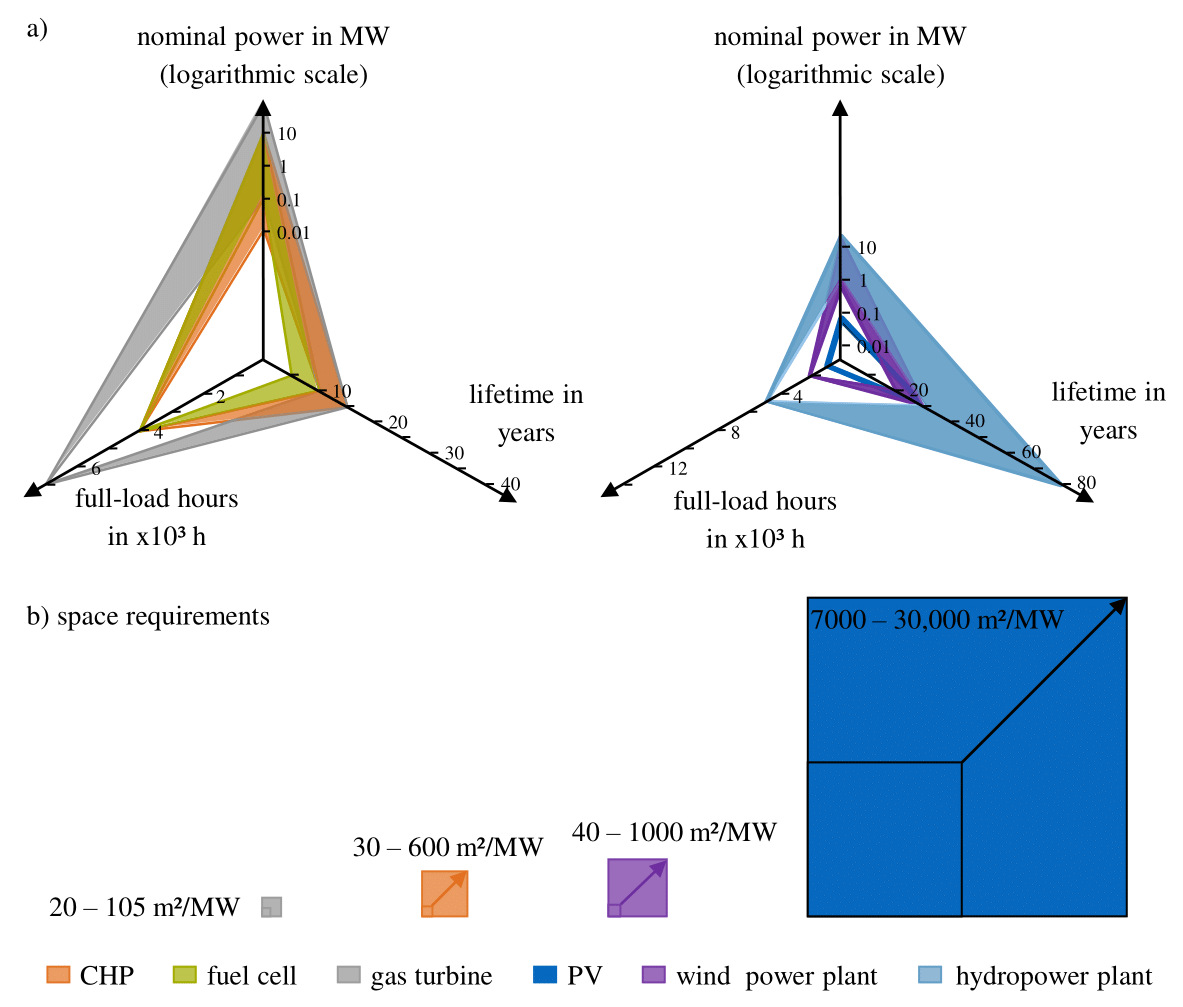
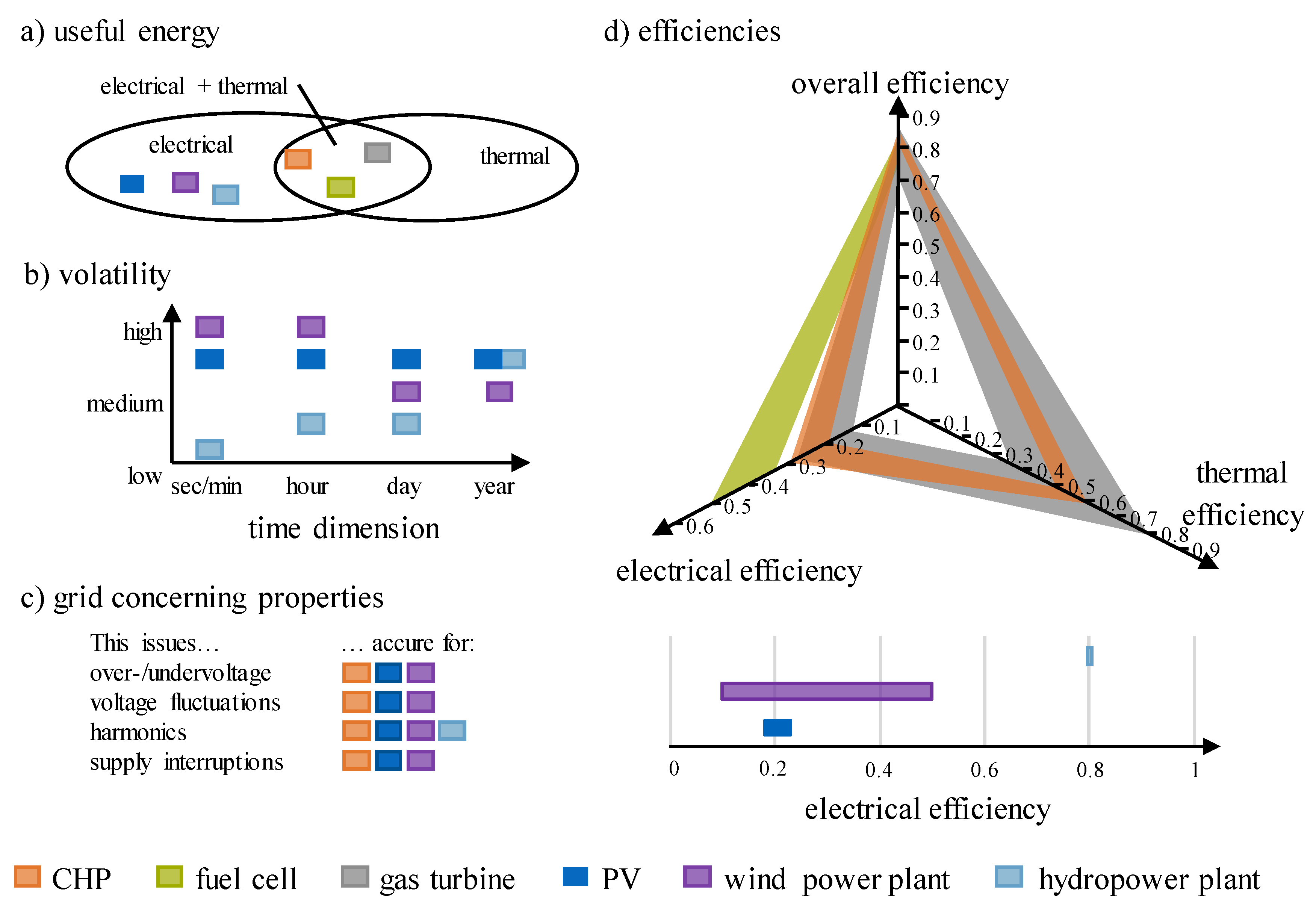
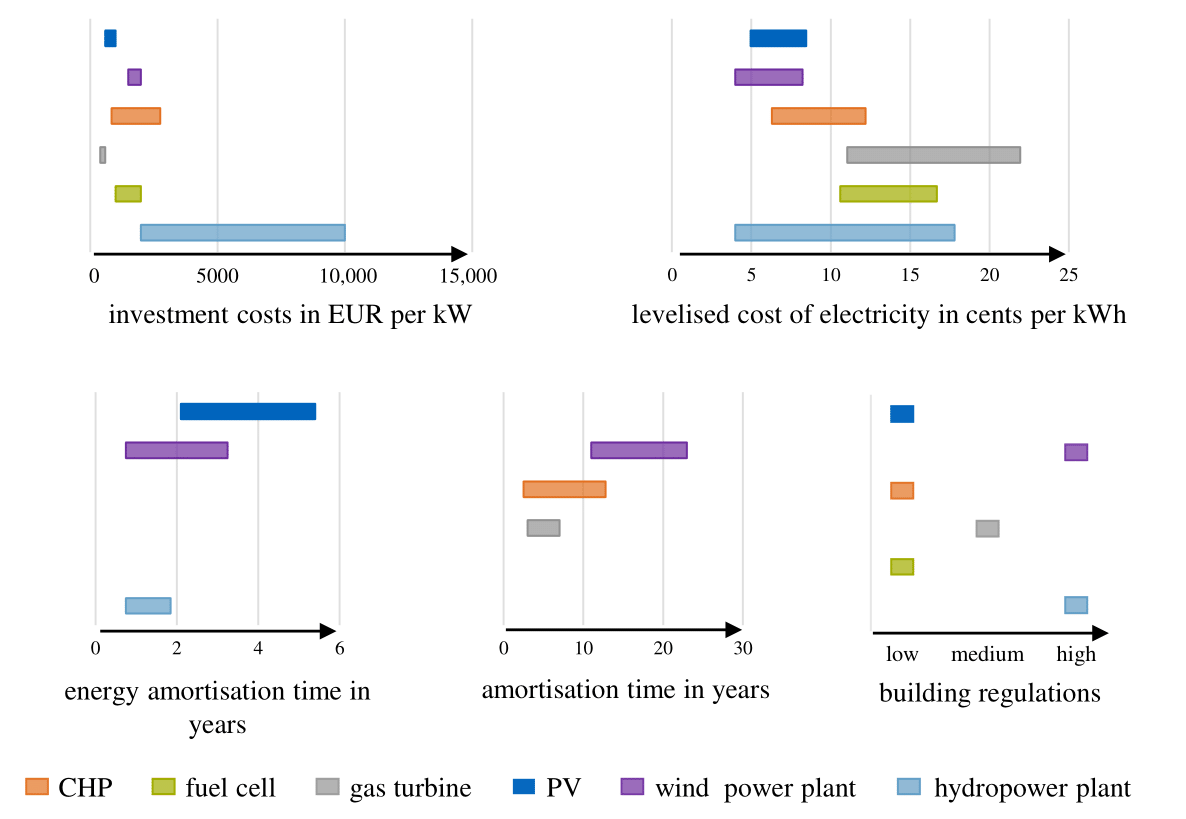

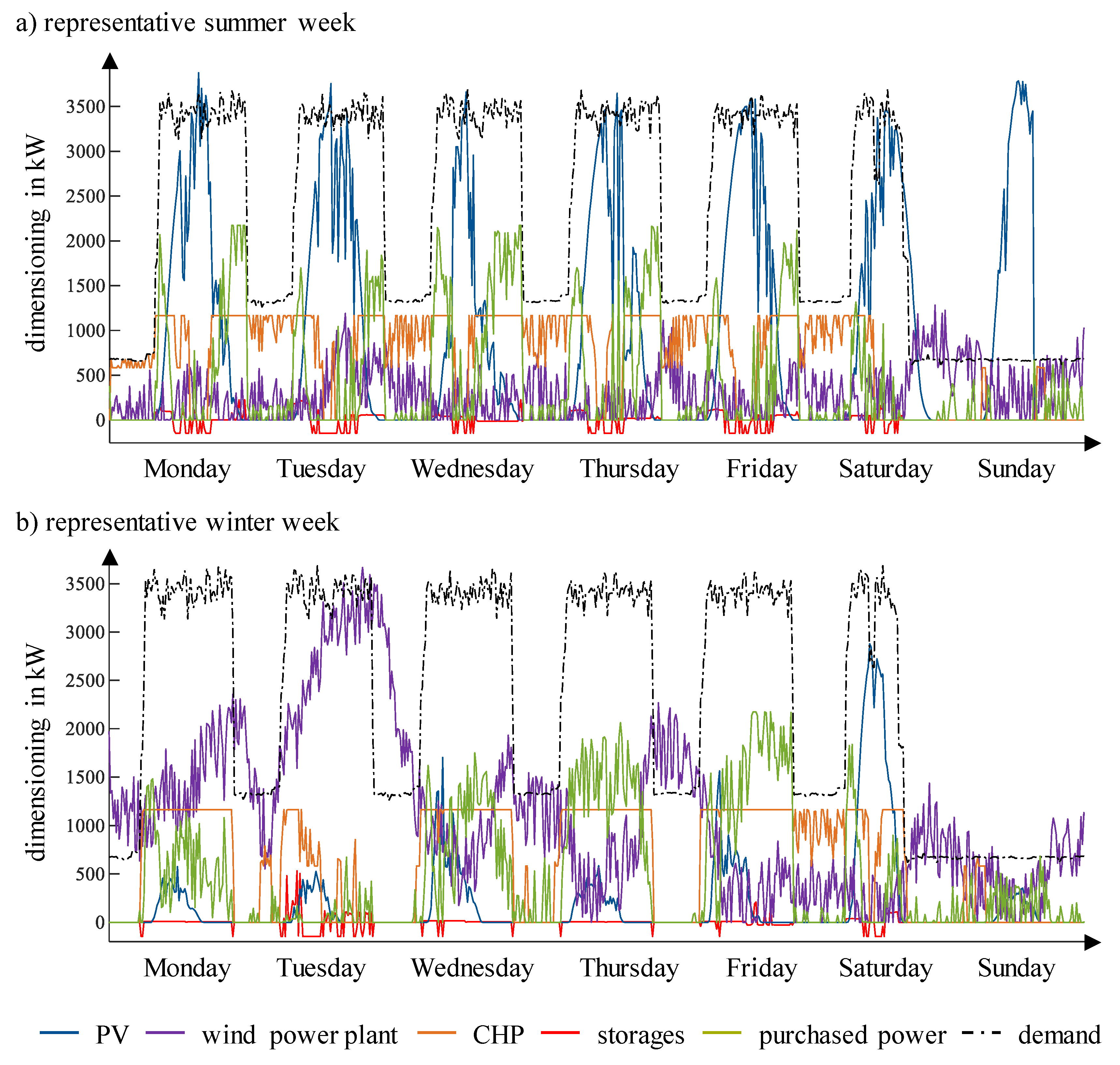

| References | Method | Objective | Considered Generation Technologies | Additional System Elements | Application Area |
|---|---|---|---|---|---|
| Atwa et al. [46] | MINLP | minimize the system’s annual energy losses | PV, wind power plant, combined heat and power plant (CHP) | grid | other non-residential use |
| Tina and Gagliano [33] | probabilistic | maximize produced electricity | PV, wind power plant | - | other non-residential use |
| Upadhyay and Sharma [47] | PSO | minimize total cost | PV, hydropower plant | BESS, diesel generator | residential use |
| Lan et al. [50] | PSO-GA | minimize costs and CO2 emissions | PV | diesel generator, BESS | other non-residential use |
| Ma et al. [48] | GA | maximize power supply reliability and minimize system lifecycle cost | PV, hydropower plant | - | residential use |
| Scheubel et al. [45] | MILP | minimize the total system cost | PV, wind power plant, CHP | diesel generator, BESS, heat storage, grid | industrial use |
| Thiem [36] | MILP | minimize the total system cost | PV | diesel generator, BESS, thermal storage, grid | other non-residential use |
| Li et al. [51] | GA-MILP | minimize the annualized cost of the system (ACS) | PV, fuel cell | BESS | residential use |
| Ming et al. [44] | DP | maximize net revenue | PV, hydropower plant | grid | other non-residential use |
| Jacob et al. [32] | graphical | minimize the life cycle cost | PV | BESS | residential use |
| Zhang et al. [52] | modified SA | minimize life cycle cost of the system | PV, wind power plant, fuel cell | BESS | residential use |
| Zhang et al. [49] | hybrid | minimize the total life cycle cost | PV, wind power plant, fuel cell | - | residential use |
| Software Solution | Optimization Reason | Time Step | Access | Technical Depth | System Size | ||||
|---|---|---|---|---|---|---|---|---|---|
| Dimensioning | Operation | Sec | Min | Hours | Month | ||||
| Balmorel | ✓ | ✓ | ✕ | ✕ | ✓ | ✓ | open-source/ commercial | – | + |
| DER-CAM | ✓ | ✓ | ✕ | ✓ | ✓ | ✕ | open-source | o | – |
| Energy Plan | ✕ | ✕ | ✓ | ✕ | open-source | – | + | ||
| HOMER Pro | ✕ | ✓ | ✓ | ✕ | commercial | o | o | ||
| MARKAL & TIMES | ✓ | ✕ | ✕ | ✓ | ✓ | open-source | – | + | |
| Top Energy | ✓ | ✕ | ✕ | ✓ | ✕ | commercial | o | o | |
| TRNSYS | ✓ | ✓ | ✓ | ✓ | ✕ | commercial | + | – | |
| urbs | ✓ | ✓ | ✕ | ✕ | ✓ | ✕ | open-source | o | + |
| Method | Technical Depth | Computation | Complexity | Local/Global Optimum | |
|---|---|---|---|---|---|
| probabilistic | - | o | + | - | |
| analytical | LP | - | o | - | + |
| MILP | + | o | o | o | |
| MINLP | + | + | + | - | |
| iterative | DP | o | - | o | - |
| GA | o | + | + | - | |
| PSO | - | o | o | - | |
| ANN | o | + | + | o | |
| PV | ||||
| power in kWp | 5–15 | 100–1000 | >1000 | |
| LCOE in ct/kWh (average value) | 9.27 [72] | 6.59 [72] | 5.13 [72] | |
| power supply per 1 kWp at optimum tilt angle in kWh/a | 1105 [72] | |||
| annual costs in €/kWp (calculated value) | 102 | 73 | 57 | |
| Wind Power | ||||
| power in MW | 2–5 | <2 | ||
| LCOE in ct/kWh | 7.48 [72] | 20 [86] | ||
| full-load hours | 1800 [87] | 1250 [88] | ||
| annual costs in €/kWp (calculated value) | 135 | 250 | ||
| Hydro Power | ||||
| power in MW | 0.2–1 | 1–2 | ||
| LCOE in ct/kWh | 14.43 [89] | 10.87 [89] | ||
| full-load hours | 3870 [89] | 4200 [89] | ||
| annual costs in €/kWp (calculated value) | 557 | 481 | ||
| CHP | ||||
| variable costs in ct/kWh (calculated value) | 7.42 [72] | |||
| fix costs in €/kW/a (calculated value) | 279 [72] | |||
Publisher’s Note: MDPI stays neutral with regard to jurisdictional claims in published maps and institutional affiliations. |
© 2021 by the authors. Licensee MDPI, Basel, Switzerland. This article is an open access article distributed under the terms and conditions of the Creative Commons Attribution (CC BY) license (https://creativecommons.org/licenses/by/4.0/).
Share and Cite
Schulz, J.; Leinmüller, D.; Misik, A.; Zaeh, M.F. Renewable On-Site Power Generation for Manufacturing Companies—Technologies, Modeling, and Dimensioning. Sustainability 2021, 13, 3898. https://doi.org/10.3390/su13073898
Schulz J, Leinmüller D, Misik A, Zaeh MF. Renewable On-Site Power Generation for Manufacturing Companies—Technologies, Modeling, and Dimensioning. Sustainability. 2021; 13(7):3898. https://doi.org/10.3390/su13073898
Chicago/Turabian StyleSchulz, Julia, Daniel Leinmüller, Adam Misik, and Michael F. Zaeh. 2021. "Renewable On-Site Power Generation for Manufacturing Companies—Technologies, Modeling, and Dimensioning" Sustainability 13, no. 7: 3898. https://doi.org/10.3390/su13073898
APA StyleSchulz, J., Leinmüller, D., Misik, A., & Zaeh, M. F. (2021). Renewable On-Site Power Generation for Manufacturing Companies—Technologies, Modeling, and Dimensioning. Sustainability, 13(7), 3898. https://doi.org/10.3390/su13073898






